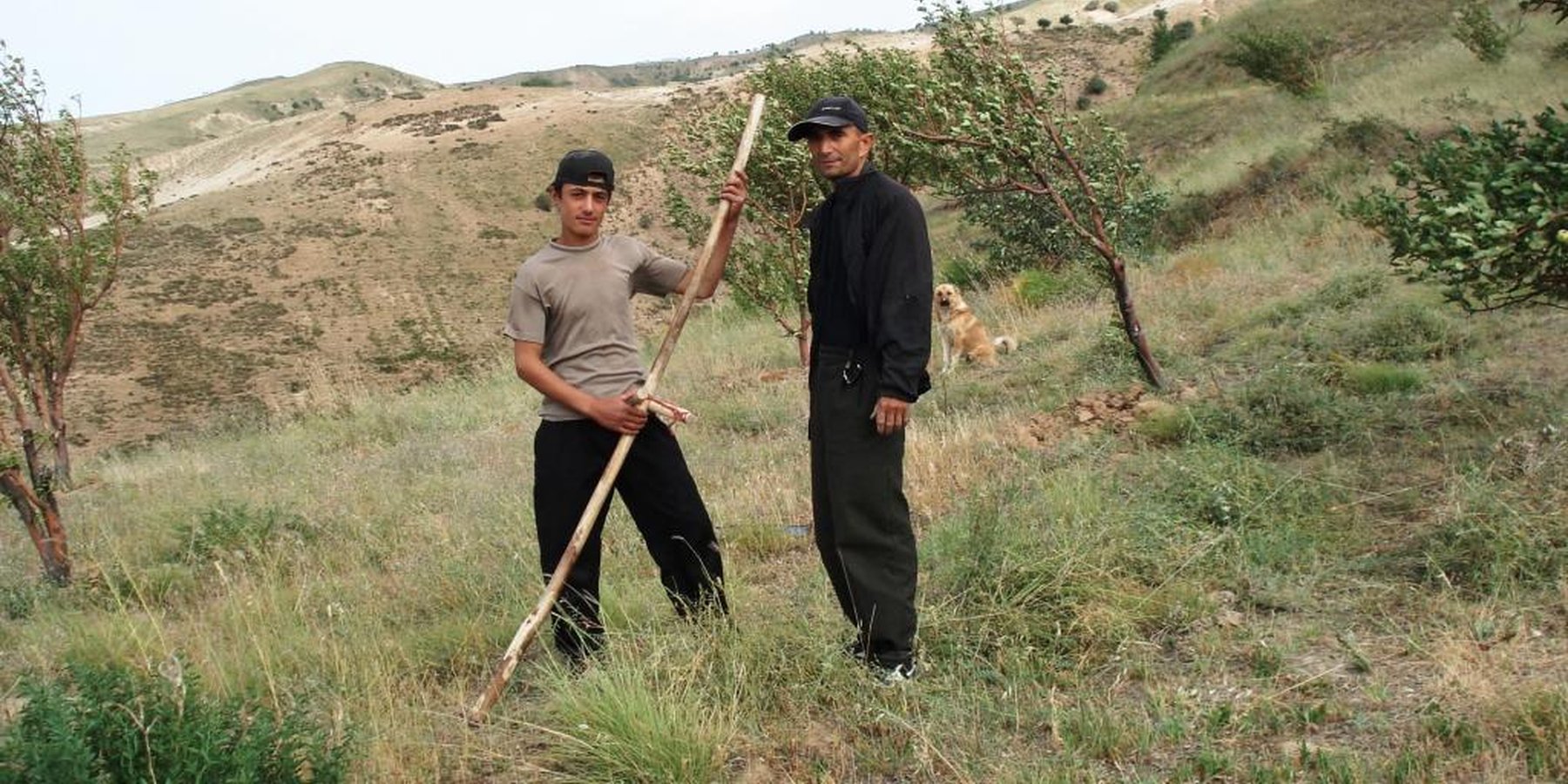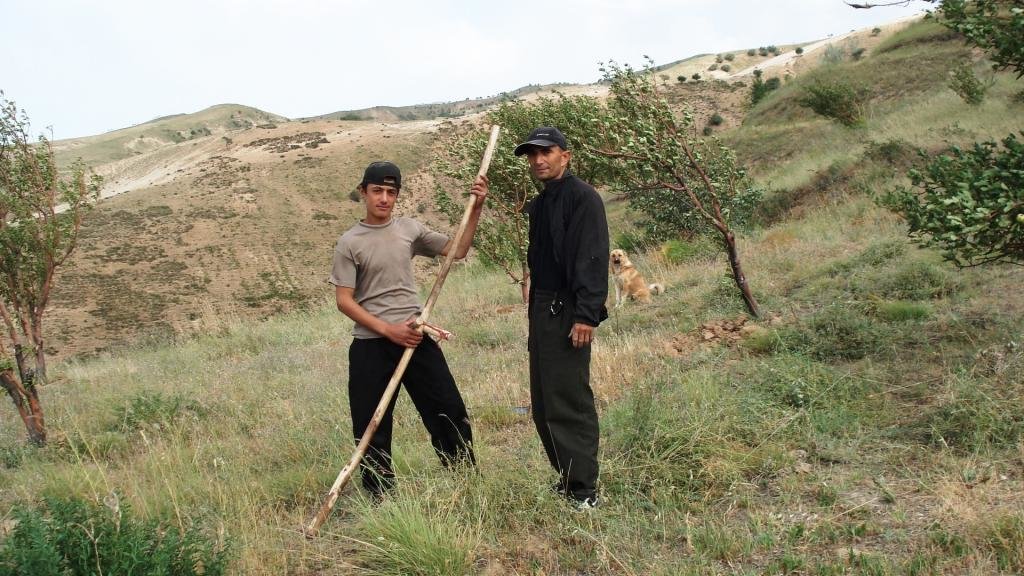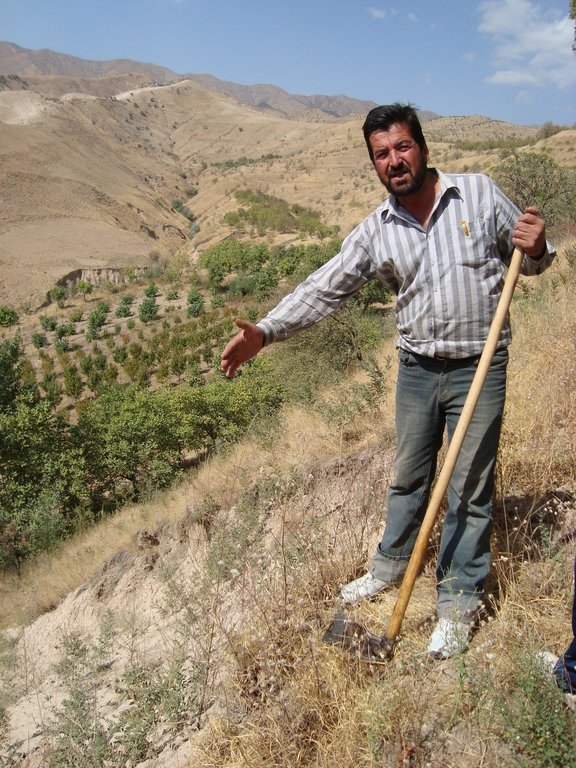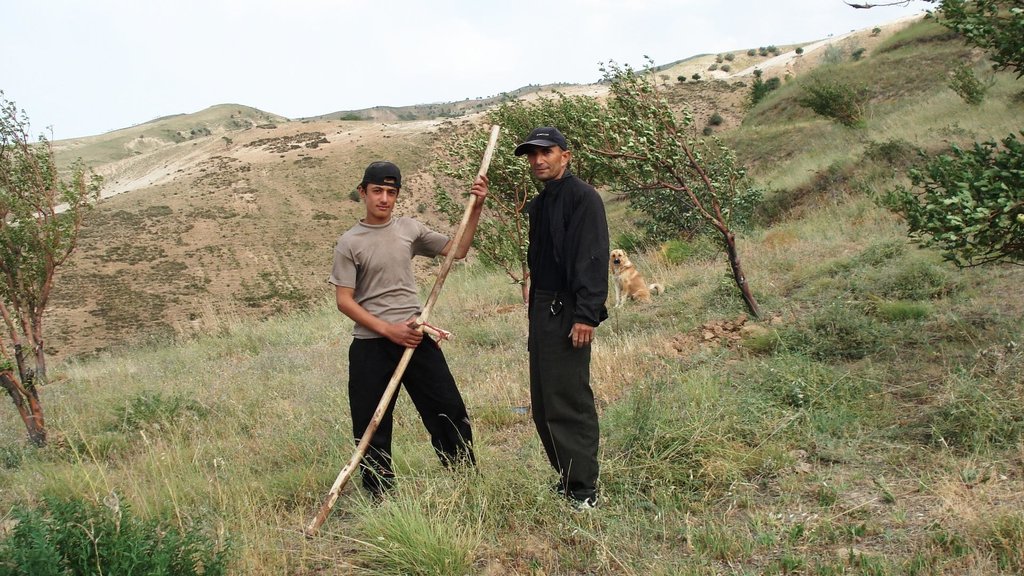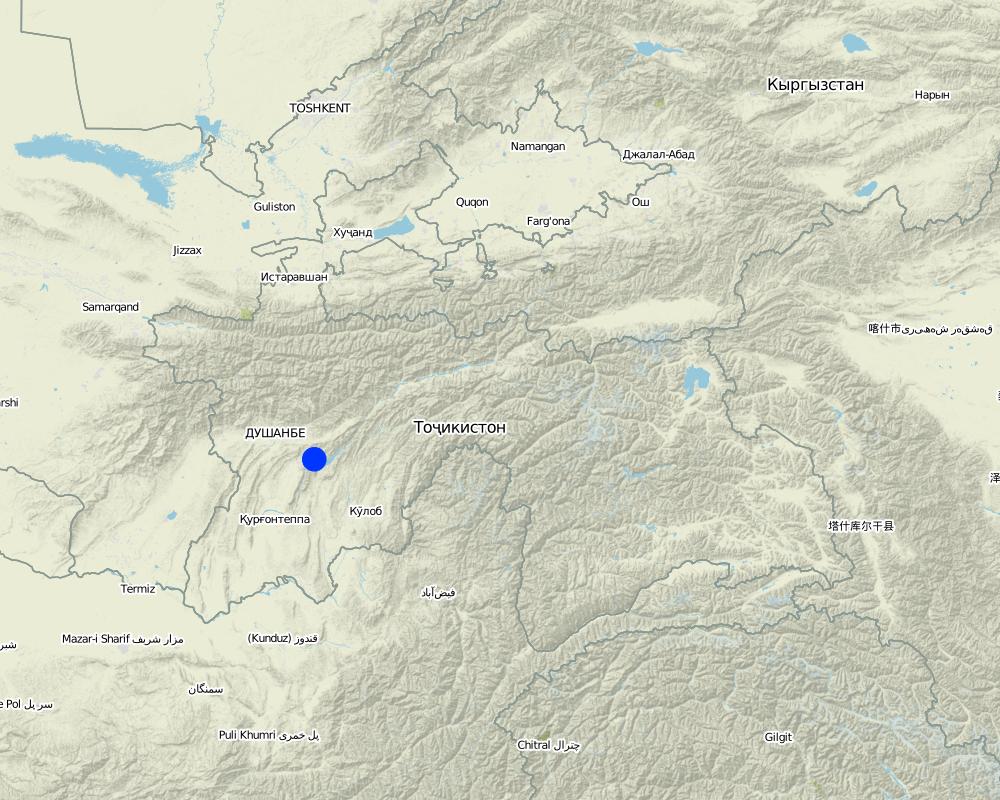State-controlled research territory for orcharding [ทาจิกิสถาน]
- ผู้สร้างสรรค์:
- การอัพเดท:
- ผู้รวบรวม: Christian Wirz
- ผู้เรียบเรียง: –
- ผู้ตรวจสอบ: David Streiff
approaches_2566 - ทาจิกิสถาน
ดูส่วนย่อย
ขยายทั้งหมด ย่อทั้งหมด1. ข้อมูลทั่วไป
1.2 รายละเอียดที่ติดต่อได้ของผู้รวบรวมและองค์กรที่เกี่ยวข้องในการประเมินและการจัดเตรียมทำเอกสารของแนวทาง
ชื่อของโครงการซึ่งอำนวยความสะดวกในการทำเอกสารหรือการประเมินแนวทาง (ถ้าเกี่ยวข้อง)
CDE Centre for Development and Environment (CDE Centre for Development and Environment) - สวิตเซอร์แลนด์1.3 เงื่อนไขที่เกี่ยวข้องกับการใช้ข้อมูลที่ได้บันทึกไว้ผ่านทาง WOCAT
วันที่เก็บรวบรวมข้อมูล (ภาคสนาม):
20/08/2008
ผู้รวบรวมและวิทยากรหลักยอมรับเงื่อนไขเกี่ยวกับการใช้ข้อมูลที่ถูกบันทึกผ่านทาง WOCAT:
ใช่
1.4 การอ้างอิงถึงแบบสอบถามเรื่องเทคโนโลยี SLM

Combined cut-and-carry and fruit-production system with terraces [ทาจิกิสถาน]
A combination of fruit- and nut-trees together with seminatural trees and shrubs on one side with grass-communities on the other side provide for a diversified production system.
- ผู้รวบรวม: Christian Wirz
2. คำอธิบายของแนวทาง SLM
2.1 การอธิบายแบบสั้น ๆ ของแนวทาง
Cultivation of an orchard with research activities and research staff with food for work.
2.2 การอธิบายอย่างละเอียดของแนวทาง
การอธิบายอย่างละเอียดของแนวทาง:
Aims / objectives: The main objective is to dispose of varieties of fruits that are adapted to different conditions. Another objective is to prevent degradation and test methods of rehabilitation and to spread this knowledge. The orchard was also implemented as a source of labour for 50 employees. In the last years it has become more important to acquire self-sufficiency by fruit- and hay-production, because wages cannot always be paid. And because of limited state-support in terms of fertilisers, pesticides and machines, the selling of tree saplings is important.
Methods: Work is subdivided into research, whereby the analysis of soils is carried out in laboratories, into conservation methods carried out by field staff and the brigadier himself (planting fruit and other trees, grafting fruit trees, planting and maintaining tree saplings, combatting pests and forbs) and harvest (of fruits and hay) that is carried out by all the employees and their families. The fruits are partly dried and sold.
Stages of implementation: After the terraces being built and the trees being planted in the early 1960ies, the orchard needed to be maintained: e.g. annually trees are substituted and fertilisers, manure and pesticides are applied. When trees are not grown, intercropping is possible. Since 1992 soils on the terraces, between the trees, are not tilled anymore, because rees are too high.
Role of stakeholders: The workers are initially employed for a clearly defined work such as tractor driver, research coordinator or research scientist. They execute orders given by their superiors. In the years after independance the strict subdivision is broken up and the research station is more independent. During civil war, when the district government was nearly inexistant, the land needed to be distributed among the employees, who were now land rentors and had to maintain their part of the orchard by themselves: It was the only way to protect the orchard from being destroyed, says the research coordinator.
2.3 รูปภาพของแนวทาง
2.5 ประเทศ ภูมิภาค หรือสถานที่ตั้งที่ได้นำแนวทางไปใช้
ประเทศ:
ทาจิกิสถาน
ภูมิภาค/รัฐ/จังหวัด: :
Region of Republican Subordination
ข้อมูลเฉพาะเพิ่มเติมของสถานที่ตั้ง:
Faizobod
ความคิดเห็น:
The research area is subdivided into two parts, one in the higher hills (around 1800-1900m) and one close to the village Karsang. Only the latter is assessed, even if the applied technology and the approach are similar for both locations.
Map
×2.6 วันที่เริ่มต้นและสิ้นสุดของแนวทาง
ระบุปีที่เริ่ม:
1965
2.7 ประเภทของแนวทาง
- ใช้โครงงานหรือแผนงานเป็นฐาน
2.8 เป้าหมายหรือวัตถุประสงค์หลักของแนวทาง
The Approach focused mainly on SLM with other activities (In the last years production (of fruits and young trees) for market and self-sufficiency has increased.)
The field station should elaborate knowledge on fruit-production in steep areas. The knowledge gained on terraces would also be useful in the 1970ies, when forest administration was implemented and started to adopt and adapt the terrace technology. Research was in cooperation with other regions of Tajikistan and the URSS, e.g. good walnut varieties from Ukraine were imported and bred to make them adapted to local climate. From the very beginning it was important integrate and to create a surplus value for local population, be it jobs or knowledge on erosion prevention and fruit-production. In the last years it has become more important to spread conservation and production knowledge in favour of local population: Workshops are regularly organised, together with NGOs and with the own specialists, to make population share the gained knowlegde and apply it in their own orchards.
The SLM Approach addressed the following problems: The main focus was research on the productivity and stress-resistance (e.g. droughts) of different varieties of fruit-trees and vines under different climatic conditions. Another important objective is the elaboration of efficient terrace technology against erosion.There were also particular interests of political leaders such as vineyards for wine-production, a factor that is not important anymore in a country where the Islamic religion seems to be more important today than in Soviet times.
2.9 เงื่อนไขที่เอื้ออำนวยหรือเป็นอุปสรรคต่อการนำเทคโนโลยีภายใต้แนวทางนี้ไปปฏิบัติใช้
กรอบแนวทางในการดำเนินการด้านกฎหมาย (การถือครองที่ดิน สิทธิในการใช้ที่ดินและน้ำ)
- เอื้ออำนวย
The existing land ownership, land use rights / water rights greatly helped the approach implementation: Land belonged to the state in former USSR and the state initiated the project.
ความรู้เกี่ยวกับ SLM การเข้าถึงการสนับสนุนด้านเทคนิค
- เป็นอุปสรรค
Topography (very steep slopes) difficult for mechanical use and dangerous for tractor drivers.
Treatment through the SLM Approach: Terraces reduce slope and besides being a better wind-protection planting the trees diagonally to the main slope direction is a
3. การมีส่วนร่วมและบทบาทของผู้มีส่วนได้ส่วนเสียที่เกี่ยวข้อง
3.1 ผู้มีส่วนได้ส่วนเสียที่เกี่ยวข้องในแนวทางนี้และบทบาท
- ผู้ใช้ที่ดินระดับท้องถิ่นหรือชุมชนระดับท้องถิ่น
Women are considered to be responsible for work in the household, even if they are sometimes the main field-workers today
- ผู้เชี่ยวชาญ SLM หรือที่ปรึกษาการเกษตร
by SLM specialists alone (top-down): Implementation and control of implementation. They are also encharged of research.
- รัฐบาลแห่งชาติ (ผู้วางแผน ผู้ทำการตัดสินใจ)
According to national and Soviet agricultural policies, the orchard was designed and organised.
Decision to implement research station (Academy of Science)
No women are found in a leading position of this research station.
3.2 การเกี่ยวข้องของผู้ใช้ที่ดินระดับท้องถิ่นหรือชุมชนระดับท้องถิ่นในช่วงต่างๆของแนวทาง
| ความเกี่ยวข้องของผู้ใช้ที่ดินระดับท้องถิ่นหรือชุมชนระดับท้องถิ่น | ระบุผู้ที่มีส่วนเกี่ยวข้องและอธิบายกิจกรรม | |
|---|---|---|
| การริเริ่มหรือการจูงใจ | ไม่มี | |
| การวางแผน | ไม่มี | |
| การดำเนินการ | ไม่ลงมือ | Tractor-driver for terraces and field staff for tree-planting, land users' families for harvesting. |
| การติดตามตรวจสอบหรือการประเมินผล | ไม่มี | |
| Research | ไม่มี |
3.4 การตัดสินใจเลือกใช้เทคโนโลยี SLM
ระบุผู้ที่ทำการตัดสินใจเลือกเทคโนโลยีมากกว่าหนึ่งวิธีไปปฏิบัติใช้:
- ผู้เชี่ยวชาญ SLM เพียงผู้เดียว
การอธิบาย:
Different experts are the decision-makers, depending on the problem (e.g. type of fruits). This has stayed till today.
Decisions on the method of implementing the SLM Technology were made by by SLM specialists alone (top-down)
4. การสนับสนุนด้านเทคนิค การสร้างขีดความสามารถ และการจัดการด้านความรู้
4.1 การสร้างขีดความสามารถ / การอบรม
ได้มีการจัดอบรมให้แก่ผู้ใช้ที่ดินหรือผู้มีส่วนได้ส่วนเสียคนอื่น ๆ หรือไม่:
ใช่
ให้ระบุว่าใครเป็นผู้ได้รับการอบรม:
- ผู้ใช้ที่ดิน
- เจ้าหน้าที่ภาคสนาม / ที่ปรึกษา
รูปแบบการอบรม:
- ใช้พื้นที่ทำการสาธิต
หัวข้อที่พูด:
For land users it is interesting to learn specific technologies in fruit-production, e.g. how walnut saplings are maintained. For field staff it is interesting to learn from specialists how something is explained to different participants (young, old).
4.2 การบริการให้คำแนะนำ
ผู้ใช้ที่ดินมีการเข้าถึงการรับบริการให้คำปรึกษาหรือไม่:
ไม่ใช่
4.3 การเสริมความแข็งแกร่งให้กับสถาบัน (การพัฒนาองค์กร)
สถาบันได้รับการจัดตั้งขึ้นมาหรือเสริมความแข็งแกร่งโดยแนวทางนี้หรือไม่:
- ไม่
4.4 การติดตามตรวจสอบและประเมินผล
การติดตามตรวจสอบและประเมินผลเป็นส่วนหนึ่งของแนวทางหรือไม่:
ใช่
ความคิดเห็น:
bio-physical aspects were regular monitored by project staff through observations; indicators: Stress-resistance, depending on climate
economic / production aspects were regular monitored by project staff through measurements; indicators: Fruit harvest per tree.
There were few changes in the Technology as a result of monitoring and evaluation: With reduced crop harvests, partly due to lacking irrigation and partly to tall trees, cropping was stopped. Instead haymaking was focused.
5. การสนับสนุนด้านการเงินและวัสดุอุปกรณ์
5.1 ระบุงบประมาณประจำปีสำหรับแนวทาง SLM นี้
แสดงความคิดเห็น (แหล่งของการระดมทุน ผู้บริจาคคนสำคัญ):
Approach costs were met by the following donors: government (In the past government paid): 100.0%
5.2 การสนับสนุนด้านการเงิน / วัสดุอุปกรณ์ให้แก่ผู้ใช้ที่ดิน
ผู้ใช้ที่ดินได้รับการสนับสนุนด้านการเงิน / วัสดุอุปกรณ์ไปปฏิบัติใช้เทคโนโลยีหรือไม่:
ไม่ใช่
5.3 เงินสนับสนุนสำหรับปัจจัยนำเข้า (รวมถึงแรงงาน)
- อุปกรณ์
| ระบุปัจจัยนำเข้าที่ได้รับการสนับสนุน | เห็นด้วยระดับไหน | ระบุเงินสนับสนุน |
|---|---|---|
| เครื่องจักร | ||
- การเกษตร
| ระบุปัจจัยนำเข้าที่ได้รับการสนับสนุน | เห็นด้วยระดับไหน | ระบุเงินสนับสนุน |
|---|---|---|
| เมล็ด | ||
| ปุ๋ย | ||
ถ้าแรงงานโดยผู้ใช้ที่ดินเป็นปัจจัยนำเข้าที่มีอยู่มากมาย ระบุด้วยว่าเนื่องจาก:
- อาหารสำหรับการทำงาน
ความคิดเห็น:
There are fix employees with monthly salaries. But often, instead of salaries, people are paid in kind (i.e. the fruits for own use are substracted from the salary).
The government paid the whole implementation of the technology.
5.5 แรงจูงใจหรือเครื่องมืออื่น ๆ
แรงจูงใจหรือเครื่องมืออื่น ๆ ได้ถูกนำไปใช้ส่งเสริมการใช้เทคโนโลยี SLM หรือไม่:
ไม่ใช่
6. การวิเคราะห์ผลกระทบและการสรุป
6.1 ผลกระทบของแนวทาง
ช่วยให้ผู้ใช้ที่ดินนำเอาเทคโนโลยี SLMไปใช้และบำรุงรักษาสภาพไว้ได้หรือไม่:
- ไม่ใช่
- ใช่ เล็กน้อย
- ใช่ ปานกลาง
- ใช่ อย่างมาก
Cover recovered on a nearby ex-cropland area, where the orchard technology was applied. It is especially the grazing-stop that triggered the change.
Did other land users / projects adopt the Approach?
- ไม่ใช่
- ใช่ เล็กน้อย
- ใช่ ปานกลาง
- ใช่ อย่างมาก
In the 1970s the forest department began with state-organised reforesting and terracing. Nowadays land users visiting workshops in the research station adopt the orchard technology, but just for self-sufficiency.
Did the Approach lead to improved livelihoods / human well-being?
- ไม่ใช่
- ใช่ เล็กน้อย
- ใช่ ปานกลาง
- ใช่ อย่างมาก
Especially the employees could profit from their job, be it by payments in kind or by the wages. During civil war the decision to leave the cultivation of the orchards to local land users did not only
Did the Approach help to alleviate poverty?
- ไม่ใช่
- ใช่ เล็กน้อย
- ใช่ ปานกลาง
- ใช่ อย่างมาก
The salaries allowed some land users to buy private livestock.
6.2 แรงจูงใจหลักของผู้ใช้ที่ดินเพื่อที่จะนำ SLM ไปปฏิบัติใช้
- การผลิตที่เพิ่มขึ้น
Especially in recent years workers have been relying more and more on harvests (fruits, hay).
- เกียรติภูมิ แรงกดดันทางสังคม ความเชื่อมแน่นทางสังคม
The employees made their living with this job.
- จิตสำนึกด้านสิ่งแวดล้อม
The brigadier was and is convinced that the ecosystem is maintained by the whole project.
6.3 ความยั่งยืนของกิจกรรมของแนวทาง
ผู้ใช้ที่ดินสามารถทำให้สิ่งต่างๆ ที่ได้ปฏิบัติใช้โดยแนวทางนี้ยั่งยืนได้หรือไม่ (โดยไม่มีการสนับสนุนจากภายนอก):
- ไม่แน่ใจ
ถ้าตอบว่าไม่หรือไม่แน่ใจ ให้ระบุและแสดงความคิดเห็น :
Already today organisations carrying out workshops or training activities are asked to pay for it: food, paper and pens for the participants have to be organised.
6.4 จุดแข็งและข้อได้เปรียบของแนวทาง
| จุดแข็ง / ข้อได้เปรียบของแนวทางในทัศนคติของผู้ใช้ที่ดิน |
|---|
| The strong focus on research helps improve the orchard. (How to sustain/ enhance this strength: Inputs from external experts (from Switzerland) could help improve the technology.) |
| จุดแข็ง / ข้อได้เปรียบของแนวทางในทัศนคติของผู้รวบรวมหรือวิทยากรหลัก |
|---|
| It helps spread knowledge on an efficient conservation technology, especially on tree planting. |
| It permits land users to learn conservation methods and to make their living at the same time. (How to sustain/ enhance this strength: Giving the land users more decision capacities might strengthen their will to implement conservation.) |
6.5 จุดอ่อน / ข้อเสียเปรียบของแนวทางและวิธีในการแก้ไข
| จุดอ่อน / ข้อเสียเปรียบในทัศนคติของผู้ใช้ที่ดิน | สามารถแก้ไขปัญหาได้อย่างไร |
|---|---|
| The chaos of war could have destroyed the orchard (people chopping trees illegally in a situation of no control). | The possibility of employees to rent land (land tenure assured) was the only possibility to save the orchard (as soon as the harvest goes to the land user, he has more interest to improve the land use). |
| จุดอ่อน / ข้อเสียเปรียบในทัศนคติของผู้รวบรวมหรือวิทยากรหลัก | สามารถแก้ไขปัญหาได้อย่างไร |
|---|---|
| Research activities and the improvement of conservation technologies depend very much on the research coordinator. | Strengthening the position of land users would help make the system more sustainable on the long-term |
ลิงก์และโมดูล
ขยายทั้งหมด ย่อทั้งหมดลิงก์

Combined cut-and-carry and fruit-production system with terraces [ทาจิกิสถาน]
A combination of fruit- and nut-trees together with seminatural trees and shrubs on one side with grass-communities on the other side provide for a diversified production system.
- ผู้รวบรวม: Christian Wirz
โมดูล
ไม่มีโมดูล


